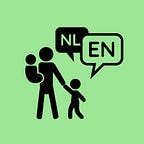Language development: The one-word stage (1;0–1;6 years)
In this blogseries I will talk about the language development or acquisition of a child, both monolingual and bilingual (or multilingual). Before start with the second stage, be sure to read the first one about preverbal development and the introductory blogpost about the different stages I will mention and the most used defining terms. If at any stage you don’t understand the abbreviations used, go check them out here!
I normally divide my post in three sections, one for monolingual development (MFLA), one for simultaneous bilingual development (BFLA) and one for sequential bilingual development (ESLA).
In this post I will talk about part 1 of the early linguistic stage. The early linguistic stage usually lasts from the 1-year mark until the age of 2;6 years. This first part is called the one-word stage or the holophrastic phase (just a fancy term for ‘one word’…). As the name is quite clear, this is the period of language development that a child speaks in singular words, and not yet in sentences.
Broadly speaking, children always develop their receptive language (understanding) first and their productive language (speaking or signing) later. In this stage, it is very important to know your child is developing rapidly and might understand more than you initially would think.
Around the age of one, babies will have said their first words. This doesn’t mean that those “words” are perfectly articulated or are even intelligeble though. Learning to speak is a continuous development and most children will also keep babbling for a while longer. Some children may stop uttering babbles altogether though, and experience a silent period with only a few words. On average, a 1;6 year old child will have 50 words they can say. They will also be able to understand around 150 words, understand simple questions and follow simple and short commands (“get your coat”, “come here”, “what’s in the box?”)
Before the actual real first words are uttered, protowords arrive. These are sounds that could be words but are not meant as a word yet (like “mama” and “dadada”), or sounds like “brrrrr” while driving a toy car. Once the child uses these sounds to indicate something intentionally, in multiple situations and multiple times, the protoword becomes a real word. Included in here are also the frozen phrases, which sound like sentences but are learned as if it was one word. Examples can be “whasis?” (what is this?) or “more bubbles” if always using the same phrase in a certain situation.
Something that happens will all children, is overextension and also underextension. Overextension occurs when a child uses a word for more than it actually means. Examples of this are calling every man ‘daddy’ or all animals ‘dogs’. Underextension is the exact oposite, for example only saying ‘cat’ to their own pet, or only calling their specific own ball a ‘ball’.
Something else that might happen is mismatching. Mismatching happens when a child gives another meaning to a word that is not at all its intended meaning. An example of this is the word “blue”. A child is often asked “do you want this pacifier, or the blue one?”. After a while the child has linked to word “blue” to the meaning of “other”. When asked whether he wants to play with a certain puzzle which he doesn’t, he says he wants the “blue one”, even though none of the puzzles have a blue colour.
Similar to the previous developmental stage, the bilingual first language acquisition in the one-word stage is almost identical to the monolingual acquisition. However, this doesn’t mean language A and B will develop exactly the same. There can be differences in the pace both (or all) languages develop, and that is no reason for concern. Most likely the language with the most and richest input, will be developing faster than the language with less input.
When stating that bilingual development is the same as monolingual development, word count is a different situation. Learning two or more languages is very much possible, but it doesn’t mean a child will be as two monolinguals in one body. Bilingual children will also meet the 50 expressive words and 150 receptive words, but this is ACROSS the languages. It could be that the child knows 25 words in each language, it could also be that they know only 3 words in language A, and 47 in language B. This is both completely normal and fine. The reason for this is that learning new words takes specific effort and brain power. As a contrast, a learned sentence structure rule, can be easily applied to all other languages (sometimes wrongly so, more about this later).
Bilingual children will often have different vocabularies in each language. Not all words will be known in both languages, as learning new words is tied to actual experiences. If language A is mainly spoken at home, and language B at daycare, the child might learn different words according to the situation.
Around the end of this one-word stage, children start to change their language usage accordingly. Their metalinguistic awareness kicks in and they switch languages when talking to people who only speak a certain language.
Similar to the last stage, many researchers don’t speak of second language acquisition or sequential bilingualism before the age of 3. While some do start after the first year, most that can be seen with these children is a relatively short silent period, and then an increasing understanding and usage of language 2.
Some children may use their first language to communicate with their surroundings, even if they are not understood. As mentioned above, around the end of this stage, children begin to consciously switch between their languages as they realise that not everyone speaks the same languages as they do.
Originally published at https://intentionallybilingual.weebly.com.
